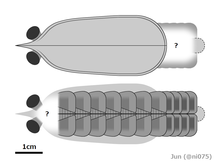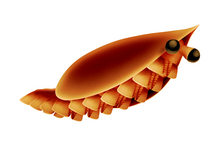Erratus
| Erratus Temporal range:
| |
|---|---|

| |
| Schematic reconstruction in dorsal and ventral views | |

| |
| Life restoration | |
| Scientific classification | |
| Domain: | Eukaryota |
| Kingdom: | Animalia |
| Phylum: | Arthropoda |
| Genus: | †Erratus Fu et al. 2022 |
| Type species | |
| Erratus sperare Fu et al. 2022
| |
Erratus
Fossils of Erratus have been found in the
deposit feeding or filter feeding
.
History of study
The
anterior spine, as well as seven anterior body fragments.[2]
Significance for understanding arthropod evolution
The relationship between the components of the
endopod (appendages), and the lopopods (stubby legs) and flaps of lobopodians and radiodonts has long been controversial. Erratus appears to show one of the earliest steps in the evolution of the endopod, with an unsclerotized endopod fused to a flap that is attached to the body wall, rather than being a branch of the appendage like an exopod. Fu et al. 2022 describes the species as having "unique trunk appendages formed of lateral anomalocaridid-type flaps and ventral subconical endopods". The fossils indicate that the species represent "an intermediate stage of biramous limb evolution".[2]
Description
Known specimens of Erratus measure 37–72 millimetres (1.5–2.8 in) in length. The arthropod had a bivalved
lenses, and the stalks appear to be as long as the eyes. On the bottom of the arthropod were 11 pairs of wide body flaps with gill-like wrinklings. The flaps decreased in size towards the bottom of the arthropod. As in gilled lobopodians and radiodonts, the flaps were connected to the body wall. The anterior 7 pairs of body flaps each possesses a medially-arranged endopod (inner branch). Each endopod was a simple, 7-segmented leg, lacking any evidences of endites (internal projections) and claws. The posterior 4 pairs of body flaps lacking endopods, but the wrinklings are more prominent. Ventral head structures between the eyes and body flaps are yet to be discovered, it is also uncertain if the trunk-end possesses a telson.[2]
Classification
| Phylogenetic position of Erratus within the arthropod stem group, after Fu et al. 2022[2]
|
A
phylogenetic analysis conducted by Fu et al. 2022 found that Erratus was a basal arthropod, branched before isoxyids (Isoxys and Surusicaris) and other euarthropods (hymenocarines, fuxianhuiids, megacheirans, trilobites and so on), but more derived than other stem-arthropods like gilled lobopodians (Pambdelurion and Kerygmachela), Opabinia and radiodonts (Anomalocaris, Hurdia and so on).[2]
Paleoecology
Erratus was a member of the
Chengjiang Biota, which dates to the Cambrian period, 520 million years ago.[2] During this time the area was a tropical region with sea level changes and tectonic activity. Most of the fauna were primarily benthic, and were probably buried via turbidity currents. Brachiopods, ctenophores, phoronids, lobopodians, worms, primitive chordates, and other arthropods are represented in the biota.[7][8] The site is known for its incredible preservation of fossils similar to that of the younger Burgess Shale.[9]
See also
- Kylinxia – Another taxon proposed to be transitional between radiodonts and euarthropods
 Marine life portal
Marine life portal
Notes
References
- ^ "Freaky 'frankenprawns': ancient deep sea monsters called radiodonts had incredible vision that likely drove an evolutionary arms race". theconversation.com. 2020.
- ^ PMID 35125000.
- ^ "New fossil reveals origin of arthropod breathing system". manchester.ac. 2022.
- ^ "520-Million-Year-Old Fossil Sheds Light on Origin of Gills in Arthropods". 2022.
- ^ "Geochronological constraint on the Cambrian Chengjiang biota, South China" (PDF). nora.nerc.ac.uk.
- ISSN 0311-5518.
- S2CID 129033570. Retrieved 2014-06-11.
- S2CID 205239797.
- .
